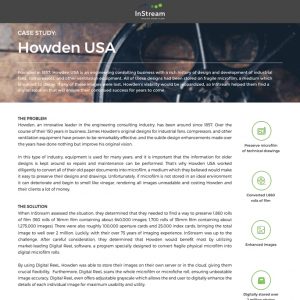Case Study: Howden USA

Founded in 1857, Howden USA is an engineering consulting business with a rich history of design and development of industrial fans, compressors, and other ventilation equipment. All of these designs had been stored on fragile microfilm, a medium which is subject to decay. If any of these images were lost, Howden’s viability would be jeopardized, so InStream helped them find a digital solution that will ensure their continued success for years to come.
THE PROBLEM
Howden, an innovative leader in the engineering consulting industry, has been around since 1857. Over the course of their 150 years in business, James Howden’s original designs for industrial fans, compressors, and other ventilation equipment have proven to be remarkably effective, and the subtle design enhancements made over the years have done nothing but improve his original vision. In this type of industry, equipment is used for many years, and it is important that the information for older designs is kept around so repairs and maintenance can be performed. That’s why Howden USA worked diligently to convert all of their old paper documents into microfilm, a medium which they believed would make it easy to preserve their designs and drawings. Unfortunately, if microfilm is not stored in an ideal environment it can deteriorate and begin to smell like vinegar, rendering all images unreadable and costing Howden and their clients a lot of money.
THE SOLUTION
When InStream assessed the situation, they determined that they needed to find a way to preserve 1,860 rolls of film (160 rolls of 16mm film containing about 640,000 images; 1,700 rolls of 35mm film containing about 1,275,000 images). There were also roughly 100,000 aperture cards and 25,000 index cards, bringing the total image to well over 2 million. Luckily, with over 75 years of imaging experience, InStream was up to the challenge. After careful consideration, they determined that Howden would benefit most by utilizing market-leading Digital ReeL software, a program specially designed to convert fragile physical microfilm into digital microfilm rolls. By using Digital ReeL, Howden was able to store their images on their own server or in the cloud, giving them crucial flexibility. Furthermore, Digital ReeL scans the whole microfilm or microfiche roll, ensuring unbeatable image accuracy. Digital ReeL even offers adjustable grayscale which allows the end-user to digitally enhance the details of each individual image for maximum usability and utility.
THE RESULTS
Digital ReeL and InStream not only saved Howden’s microfilm but made it much easier for their engineers to access the technical drawings by making them all digitally available. Digital ReeL even preserved the indexing system that Howden was already using, allowing for a seamless transition. Going forward, Howden is no longer tied down by their film viewing equipment. Digital ReeL’s intuitive interface makes it easy to find and display any image on any digital device, including desktops, laptops, tablets, and even smartphones. In the end, InStream was able to save Howden time and money, increasing efficiency, and preserving the company’s most important documents forever.
View the full case study below